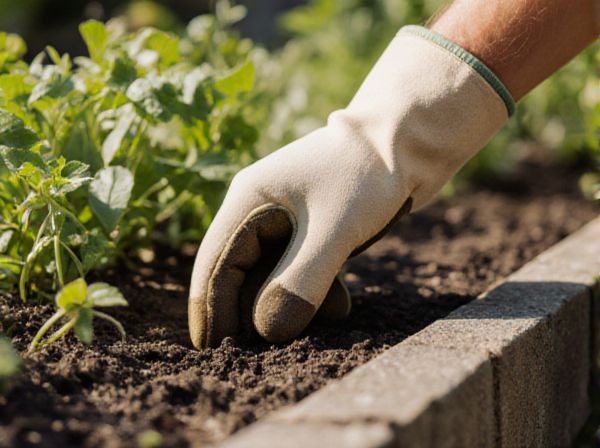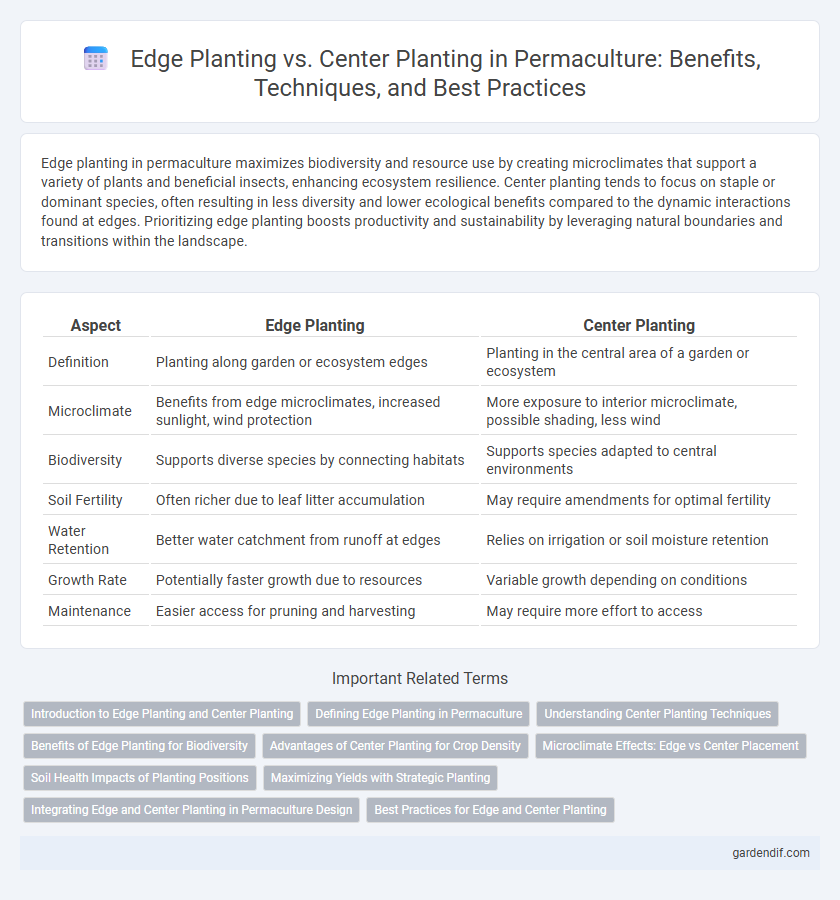
edge planting vs center planting Illustration
Edge planting in permaculture maximizes biodiversity and resource use by creating microclimates that support a variety of plants and beneficial insects, enhancing ecosystem resilience. Center planting tends to focus on staple or dominant species, often resulting in less diversity and lower ecological benefits compared to the dynamic interactions found at edges. Prioritizing edge planting boosts productivity and sustainability by leveraging natural boundaries and transitions within the landscape.
Table of Comparison
| Aspect | Edge Planting | Center Planting |
|---|---|---|
| Definition | Planting along garden or ecosystem edges | Planting in the central area of a garden or ecosystem |
| Microclimate | Benefits from edge microclimates, increased sunlight, wind protection | More exposure to interior microclimate, possible shading, less wind |
| Biodiversity | Supports diverse species by connecting habitats | Supports species adapted to central environments |
| Soil Fertility | Often richer due to leaf litter accumulation | May require amendments for optimal fertility |
| Water Retention | Better water catchment from runoff at edges | Relies on irrigation or soil moisture retention |
| Growth Rate | Potentially faster growth due to resources | Variable growth depending on conditions |
| Maintenance | Easier access for pruning and harvesting | May require more effort to access |
Introduction to Edge Planting and Center Planting
Edge planting maximizes biodiversity and microclimates by utilizing the transitional zones between different ecosystems, creating diverse habitats that enhance soil fertility and pest control. Center planting focuses on optimizing space and resource use within the core area of a garden or agroforestry system, promoting deeper root growth and greater plant stability. Both techniques complement permaculture principles by enhancing ecosystem resilience and productivity through strategic spatial arrangement.
Defining Edge Planting in Permaculture
Edge planting in permaculture involves cultivating crops or plants along the boundaries of garden beds, ponds, or natural landscape features to maximize microclimates and biodiversity. These edge zones create transitional areas where sunlight, moisture, and nutrient availability are often higher, promoting vigorous plant growth and beneficial insect activity. By leveraging the ecological advantages of edges, permaculture practitioners enhance productivity and resilience within their systems.
Understanding Center Planting Techniques
Center planting techniques in permaculture focus on maximizing resource use efficiency by strategically placing plants in the middle of growing beds or guilds. This method promotes optimal root expansion, improved water retention, and enhanced microclimates by leveraging the surrounding edge plants for wind protection and nutrient sharing. Understanding spatial relationships and plant compatibility within the center allows for increased yields and resilient ecosystem dynamics.
Benefits of Edge Planting for Biodiversity
Edge planting in permaculture enhances biodiversity by creating diverse microhabitats that support various species of insects, birds, and beneficial microorganisms. This technique maximizes sunlight exposure and airflow, promoting healthier plant growth and natural pest control. The increased plant diversity at edges fosters ecological balance, improving soil fertility through integrated nutrient cycling.
Advantages of Center Planting for Crop Density
Center planting maximizes crop density by utilizing space more efficiently, promoting stronger root systems through reduced competition at the edges. It creates a microenvironment that enhances moisture retention and nutrient availability, leading to improved plant health and yield. This method also facilitates easier access for maintenance and harvesting, optimizing overall productivity in permaculture designs.
Microclimate Effects: Edge vs Center Placement
Edge planting in permaculture leverages microclimate benefits by exposing plants to increased sunlight, wind protection, and enhanced biodiversity, fostering healthier growth and resilience. Center planting typically experiences more stable but less dynamic microclimate conditions, with moderated temperature and humidity levels beneficial for shade-tolerant species. Strategic placement based on microclimate effects maximizes resource use efficiency and supports diverse plant communities.
Soil Health Impacts of Planting Positions
Edge planting enhances soil health by increasing biodiversity and promoting beneficial microbe activity through varied root zones and organic matter input. Center planting tends to compact soil due to concentrated root systems, reducing aeration and microbial diversity essential for nutrient cycling. Optimizing planting positions with edge techniques fosters improved soil structure, moisture retention, and long-term fertility in permaculture systems.
Maximizing Yields with Strategic Planting
Edge planting in permaculture leverages microclimates and increased biodiversity at plot perimeters, boosting yields by enhancing sunlight exposure and reducing wind stress on crops. Center planting, while offering uniform soil conditions, often results in lower productivity due to less environmental variation and reduced access for beneficial insects. Strategic placement prioritizes edge zones for high-value or sensitive plants to maximize resource use and optimize overall food production efficiency.
Integrating Edge and Center Planting in Permaculture Design
Integrating edge and center planting in permaculture design maximizes biodiversity and resource efficiency by utilizing microclimates and varying sun exposure. Edge planting promotes increased plant diversity and habitat complexity, while center planting supports core crops with optimal growing conditions. Together, this approach enhances ecosystem resilience, soil health, and yields through strategic spatial arrangement.
Best Practices for Edge and Center Planting
Edge planting maximizes sunlight exposure and promotes biodiversity by placing diverse species that attract beneficial insects and improve soil health along boundaries. Center planting works best with taller, shade-tolerant plants that create microclimates and protect understory crops from wind stress. Integrating strategic spacing, companion species, and soil amendments at both edge and center zones enhances overall permaculture yield and ecosystem resilience.
edge planting vs center planting Infographic

 gardendif.com
gardendif.com